► Nissan Ariya price and spec update
► 63kWh variants now £3k cheaper
► Evolve+ trim level boasts 389bhp
Nissan has slashed the price of its Ariya electric SUV. With the introduction of a new entry-level variant, the Nissan Ariya Engage, you can now get your hands on one for £39,645 – over £6000 less than the previous cheapest version.
At the same time, Nissan has knocked £3000 off every existing version fitted with the smaller 63kWh battery, while a new Evolve+ model at the top of the range finally brings the 389bhp Ariya performance variant to the UK. Though this is a still heady £59,025, it does have nearly 29 per cent more power…
So how many different Nissan Ariya variants are there now?
The Engage and Evolve+ are on sale now as additions to the current line-up of Advance and the Evolve models, both of which are still available.
The Engage 2WD is front-wheel drive only, but can be had with the larger 87kWh battery pack as well as the smaller 63kWh unit. That means a projected driving range of 330 or 251 miles and a power output of 239bhp or 214bhp, respectively.
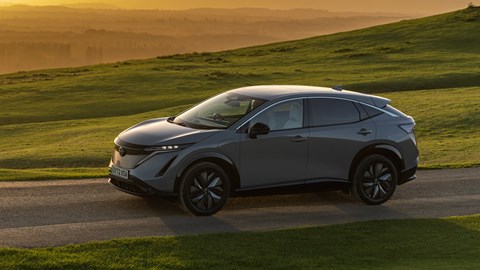
The Advance and Evolve are also available with both battery / drivetrain versions, albeit with slightly reduced efficiency due to their additional equipment. The larger battery capacity is offered with the optional e-4ORCE dual-motor all-wheel drive system, too. This punches out 302bhp, dropping the 0-62mph time from 7.5sec to 5.7sec, but also reducing maximum range to 314-319 miles per charge.
Finally, the new Ariya Evolve+ is a dual-motor model with the 87kWh battery and power increased to 389bhp. With 442lb ft as well, this is capable of 0-62mph in 5.1sec and – Nissan says – 310 miles.
The basic Engage model is still generously equipped, with highlights including dual 12.0-inch screens (with nav, CarPlay and Android Auto) on the inside, 19-inch alloys, LED headlights and heated, folding mirrors on the outside. Upgrades for the Evolve+ over the regular Evolve include 20-inch alloys and Nappa Blue leather.
What are the other Ariya FAQs?
The Ariya SUV is Nissan’s second pure electric car, after the Leaf EV, and first went on sale in the UK in summer 2022. It’s underpinned by the Renault-Nissan Alliance’s scalable CMF-EV platform.
The batteries (which are long and flat) are mounted under the car’s floor and, as there’s no need to make space in the body for a gearbox or exhaust system, there’s no central tunnel. That means the floor is completely flat, which makes the Ariya considerably more spacious inside than its combustion-engined counterparts. It’s especially noticeable in the back, where legroom is similar to that of the larger Audi Q5.
The obvious electric car rivals are the Tesla Model Y and Volkswagen ID.4.
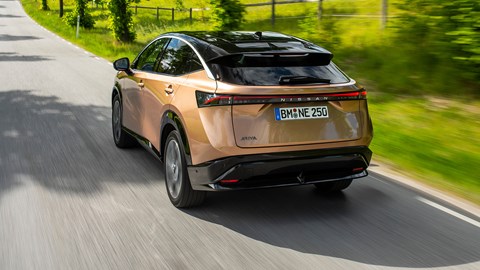
The strange e-4ORCE badge refers to the torque management system of the dual-motor versions, which can independently control the amount of power being sent to the front and rear axles. The system can’t manage the torque split across each axle, but the Ariya can independently brake each wheel to improve its cornering ability.
Models with twin motors can also shut off the rear one when cruising on a motorway. However, the system won’t be able to shut off the front one for rear-wheel drive silliness. As for weight, it comes in at a EV-typical 1800-2300kg.
What about the charging technology?
The Ariya gets a Combined Charging System (CCS) connector for the European market. Charging tech includes a battery thermal control feature for its liquid-cooled and heated battery and the Ariya 63kWh versions have a 7.4kW charger for domestic use.
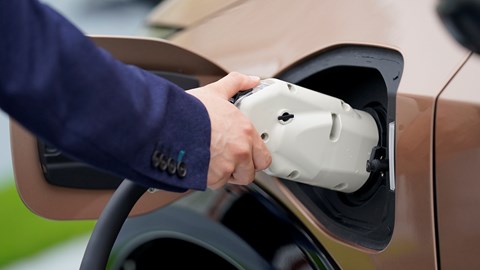
The 87kWh version can support a 22kW three-phase charger for home charging – as long as your home does. For those using public chargers, the good news is that it supports rapid charging up to 130kW.
Design
The Ariya is a handsome thing with clean surfaces and a striking graphical face, including ‘boomerang’ LED lights and a closed off grille for aerodynamic reasons. ‘Electric power is this clean powerful energy, so we wanted to echo that clean powerful surface,’ Giovanny Arroba, Nissan’s EV Design Director (below) told CAR.
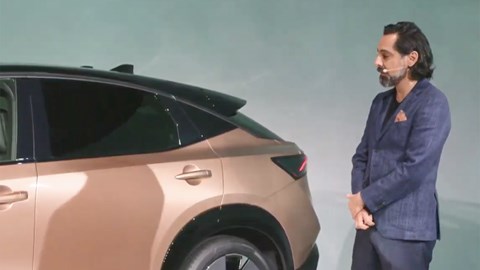
Indeed, the overall teardrop shape looks honed in the wind tunnel, to boost range. Air intakes at the front of the Ariya also create ‘air curtains’ which help keep air attached to the side of the car.
‘We wanted to express the technology that we’re bringing to market, this kind of democratisation of electric and technology, which we call intelligent mobility design,’ said Arroba.
The replacement of the Nissan V-motion grille with a shield design is a big change in direction: ‘It was an open grille and was feeding the internal combustion engine with cooling air,’ explains Arroba. ‘That has been replaced with this technology shield which packages are radar and camera.’
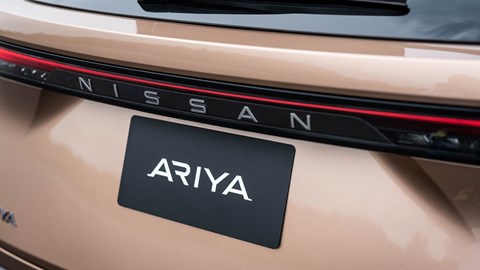
The shield – along with the incisive-looking DRLs it melts into are surely the most striking part of the Ariya, and they’re a new signature for Nissan electric cars. ‘I think the shield in combination with the signature lamps, that frame that face, that combination shows our brand identity, electrified,’ he confirmed.
‘The Ariya’s proportions show what’s possible with Nissan’s 100% electric vehicle platform, said Alfonso Albaisa, Nissan’s senior vice president of global design at the Tokyo motor show. ‘The surprisingly short overhangs, large cabin, large wheels and tailored two-tone paint scheme provide an elegant appearance that balances sport and luxury.’
It’s an entirely new design direction for Nissan, the first example of our new vision for our design language, which we call Timeless Japanese Futurism,’ said Albaisa.
Interior and technology
The Ariya isn’t all joysticks and VR headsets. There’s a conventional 12.3-inch infotainment screen and a 12.3-inch drive display. There are very few ‘real’ buttons as most are touch-sensitive with haptic feedback.‘This car lives in a world where you still can engage and drive with the tactile feel of the steering wheel,’ Arroba assured us.
The Ariya is a one-pedal car to drive, just like the Leaf. It can accelerate, and brake following the car in front and keep within lane, as well as undertake hands-off driving between highway junctions so long as you’ve set the navigation – just like the current Japanese-market Skyline. But next-gen features include automated overtaking, lane diversions and piloted exiting of the highway.
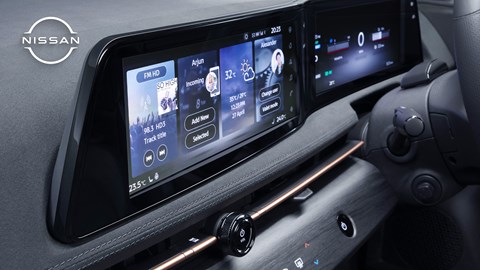
Drivers okay the transfer to automated driving via a button; the pared-back interior lighting switches at that point to signify a more relaxed state. Whether the driver stays that way depends on how polished and bulletproof ProPilot 2.0 turns out to be.
The Ariya gets the latest version of ProPilot. It also has a series of connected features. As soon as the key is detected, the seats and vehicle settings change to match the driver’s preferences. It’s connected, too, and offers ‘hey Nissan’ and Alexa voice command functionality.
More space inside
Like many other electric cars, its interior is also more spacious than you’d expect: Nissan has been able to move A/C components from the interior – where they’d usually be packaged – to the ‘engine bay’ and given back the occupants some real estate in the process. Remove the transmission tunnel, and there’s considerably more space in the Ariya than its outside shape suggests. In fact, it’s more D-segment inside, than its C-segment exterior.
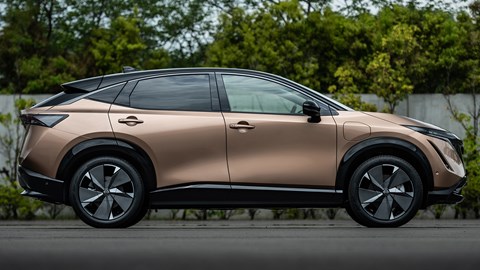
As the A/C sits where a traditional engine would, there’s no frunk like with a Tesla. But the boot is big. There’s 468-litres worth of space in the front-wheel drive versions, but only 415-litres in the all-wheel drive models.